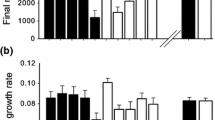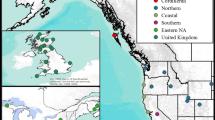Abstract
The evolution of increased competitive ability (EICA) hypothesis predicts that release from natural enemies in the introduced range favors exotic plants evolving to have greater competitive ability and lower herbivore resistance than conspecifics from the native range. We tested the EICA hypothesis in a common garden experiment with Sapium sebiferum in which seedlings from native (China) and invasive (USA) populations were grown in all pairwise combinations in the native range (China) in the presence of herbivores. When paired seedlings were from the same continent, shoot mass and leaf damage per seedling were significantly greater for plants from invasive populations than those from native populations. Despite more damage from herbivores, plants from invasive populations still outperformed those from native populations when they were grown together. Increased competitive ability and higher herbivory damage of invasive populations relative to native populations of S. sebiferum support the EICA hypothesis. Regression of biomass against percent leaf damage showed that plants from invasive populations tolerated herbivory more effectively than those from native populations. The results of this study suggest that S. sebiferum has become a faster-growing, less herbivore-resistant, and more herbivore-tolerant plant in the introduced range. This implies that increased competitive ability of exotic plants may be associated with evolutionary changes in both resistance and tolerance to herbivory in the introduced range. Understanding these evolutionary changes has important implications for biological control strategies targeted at problematic invaders.



Similar content being viewed by others
References
Agrawal AA, Conner JK, Stinchcombe JR (2004) Evolution of plant resistance and tolerance to frost damage. Ecol Lett 7:1199–1208
Bastlová D, Květ J (2002) Differences in dry weight partitioning and flowering phenology between native and non-native plants of purple loosestrife (Lythrum salicaria L.). Flora 197:332–340
Blair AC, Wolfe LM (2004) The evolution of an invasive plant: an experimental study with Silene latifolia. Ecology 85:3035–3042
Blossey B, Nötzold R (1995) Evolution of increased competitive ability in invasive nonindigenous plants: a hypothesis. J Ecol 83:887–889
Bossdorf O, Prati D, Auge H, Schmid B (2004a) Reduced competitive ability in an invasive plant. Ecol Lett 7:346–353
Bossdorf O, Schröder S, Prati D, Auge H (2004b) Palatability and tolerance to simulated herbivory in native and introduced populations of Alliaria petiolata (Brassicaceae). Am J Bot 91:856–862
Bossdorf O, Auge H, Lafuma L, Rogers WE, Siemann E, Prati D (2005) Phenotypic and genetic differentiation in native versus introduced plant populations. Oecologia 144:1–11
Bruce KA, Cameron GN, Harcombe PA, Jubinsky G (1997) Introduction, impact on native habitats, and management of a wood invader, the Chinese tallow tree, Sapium sebiferum (L.) Roxb. Nat Areas J 17:255–260
Buschmann H, Edwards PJ, Dietz H (2005) Variation in growth pattern and response to slug damage among native and invasive provenances of four perennial Brassicaceae species. J Ecol 93:322–334
Callaway RM, Aschehoug ET (2000) Invasive plants versus their new and old neighbors: a mechanism for exotic invasion. Science 290:521–523
Davis MA, Grime JP, Thompson K (2000) Fluctuating resources in plant communities: a general theory of invisibility. J Ecol 88:528–534
DeWalt SJ, Denslow JS, Ickes K (2004) Natural-enemy release facilitates habitat expansion of the invasive tropical shrub Clidemia hirta. Ecology 85:471–483
DeWalt SJ, Siemann E, Rogers WE (2006) Microsatellite markers for an invasive tetraploid tree, Chinese Tallow (Triadica sebifera). Mol Ecol Notes 6:505–507
Elberse IAM, Turin JHB, Wäckers FL, van Damme JMM, van Tienderen PH (2003) The relationship between relative growth rate and susceptibility to aphids in wild barley under different nutrient levels. Oecologia 137:564–571
Erfmeier A, Bruelheide H (2005) Invasive and native Rhododendron ponticum populations: is there evidence for genotypic differences in germination and growth? Ecography 28:417–428
Goldberg DE (1996) Competitive ability: definitions, contingency and correlated traits. Philos Trans R Soc B 351:1377–1385
García LV (2004) Escaping the Bonferroni iron claw in ecological studies. Oikos 105:657–663
Grime JP (1979) Plant strategies and vegetation processes. Wiley, Chichester, UK
Grotkopp E, Rejmánek M, Rost TL (2002) Toward a causal explanation of plant invasiveness: seedling growth and life-history strategies of 29 pine (Pinus) species. Am Nat 159:396–419
Güsewell S, Jakobs G, Weber E (2006) Native and introduced populations of Solidago gigantea differ in shoot production but not in leaf traits or litter decomposition. Funct Ecol 20:575–584
Hierro JL, Maron JL, Callaway RM (2005) A biogeographical approach to plant invasions: the importance of studying exotics in their introduced and native range. J Ecol 93:5–15
Jones RH, McLeod KW (1990) Growth and photosynthetic responses to light environment in Chinese tallow tree and Carolina ash seedlings. Forest Sci 36:851–862
Joshi J, Vrieling K (2005) The enemy release and EICA hypothesis revisited: incorporating the fundamental difference between specialist and generalist herbivores. Ecol Lett 8:704–714
Keane RM, Crawley MJ (2002) Exotic plant invasions and the enemy release hypothesis. Trends Ecol Evol 17:164–170
van Kleunen M, Schmid B (2003) No evidence for evolutionary increased competitive ability (EICA) in the invasive plant Solidago canadensis. Ecology 84:2824–2831
Leger EA, Rice KJ (2003) Invasive California poppies (Eschscholzia californica Cham.) grow larger than native individuals under reduced competition. Ecol Lett 6:257–264
Leger EA, Forister ML (2005) Increased resistance to generalist herbivores in invasive populations of the California poppy (Eschscholiza californica). Divers Distrib 11:311–317
Liu H, Stiling P (2006) Testing the enemy release hypothesis: a review and meta-analysis. Biol Invasions 8:1535–1545
Maron JL, Vilà M (2001) When do herbivores affect plant invasion? Evidence for the natural enemies and biotic resistance hypotheses. Oikos 95:361–373
Maron JL, Vilà M, Bommarco R, Elmendorf S, Beardsley P (2004) Rapid evolution of an invasive plant. Ecol Monogr 74:261–280
Maxwell SE, Delaney HD (1990) Designing experiments and analyzing data: a model comparison perspective. Belmont, Wadsworth, CA
McDowell SCL (2002) Photosynthetic characteristics of invasive and noninvasive species of Rubus (Rosaceae). Am J Bot 89:1431–1438
van der Meijden E, Wijn M, Verkaar HJ (1988) Defence and regrowth, alternative plant strategies in the struggle against herbivores. Oikos 51:355–363
van der Meijden E (1996) Plant defence, an evolutionary dilemma: contrasting effects of (specialist and generalist) herbivores and natural enemies. Entomol Exp Appl 80:307–310
Memmott J, Fowler SV, Paynter Q, Sheppard AW, Syrett P (2000) The invertebrate fauna on broom, Cytisus scopartius, in two native and two exotic habitats. Acta Oecol 21:213–222
Meyer G, Clare R, Weber E (2005) An experimental test of the evolution of increased competitive ability hypothesis in goldenrod, Solidago gigantea. Oecologia 144:299–307
Mooney HA, Cleland EE (2001) The evolutionary impact of invasive species. Proc Natl Acad Sci USA 98:5446–5451
Müller C, Martens N (2005) Testing predictions of the ‘evolution of increased competitive ability’ hypothesis for an invasive crucifer. Evol Ecol 19:533–550
Müller-Schärer H, Schaffner U, Steinger T (2004) Evolution in invasive plants: implications for biological control. Trends Ecol Evol 19:418–422
Parker JD, Hay ME (2005) Biotic resistance to plant invasions? Native herbivores prefer non-native plants. Ecol Lett 8:959–967
Parker JD, Burkepile DE, Hay ME (2006) Opposing effects of native and exotic herbivores on plant invasions. Science 311:1459–1461
Pattison RR, Goldstein G, Ares A (1998) Growth, biomass allocation and photosynthesis of invasive and native Hawaiian rainforest species. Oecologia 117:449–459
Rogers WE, Siemann E (2004) Invasive ecotypes tolerate herbivory more effectively than native ecotypes of the Chinese tallow tree Sapium sebiferum. J Appl Ecol 41:561–570
Rogers WE, Siemann E (2005) Herbivory tolerance and compensatory differences in native and invasive ecotypes of Chinese tallow tree (Sapium sebiferum). Plant Ecol 181:57–68
Rosenthal JP, Kotanen PM (1994) Terrestrial plant tolerance to herbivory. Trends Ecol Evol 9:145–148
Siemann E, Rogers WE (2001) Genetic differences in growth of an invasive tree species. Ecol Lett 4:514–518
Siemann E, Rogers WE (2003a) Reduced resistance of invasive varieties of the alien tree Sapium sebiferum to a generalist herbivore. Oecologia 135:451–457
Siemann E, Rogers WE (2003b) Increased competitive ability of an invasive tree may be limited by an invasive beetle. Ecol Appl 13:1503–1507
Siemann E, Rogers WE (2003c) Herbivory, disease, recruitment limitation and success of alien and native tree species. Ecology 84:1489–1505
Siemann E, Rogers WE, DeWalt SJ (2006) Rapid adaptation of insect herbivores to an invasive plant. P Roy Soc B-Biol Sci 273:2763–2769
Smith MD, Knapp AK (2001) Physiological and morphological traits of exotic, invasive exotic, and native plant species in tallgrass prairie. Int J Plant Sci 162:785–792
Stastny M, Schaffner U, Elle E (2005) Do vigour of introduced populations and escape from specialist herbivores contribute to invasiveness? J Ecol 93:27–37
Stowe KA, Marquis RJ, Hochwender CG, Simms EL (2000) The evolutionary ecology of tolerance to consumer damage. Annu Rev Ecol Evol S 31:565–595
Strauss S, Agrawal A (1999) The ecology and evolution of tolerance to herbivory. Trends Ecol Evol 14:179–185
Thompson JN (1998) Rapid evolution as an ecological process. Trends Ecol Evol 13:329–332
Tiffin P (2000) Are tolerance, avoidance, and antibiosis evolutionarily and ecologically equivalent responses of plants to herbivores? Am Nat 155:128–138
Vilà M, Gómez A, Maron J (2003) Are alien plants more competitive than their native conspecifics? A test using Hypericum perforatum L. Oecologia 137:211–215
Vitousek PM, D’Antonio CM, Loope LL, Westbrooks R (1996) Biological invasions as global environmental change. Am Sci 84:218–228
Wilcove DS, Rothstein D, Bubow J, Phillips A, Losos E (1998) Quantifying threats to imperiled species in the United States. Bioscience 48:607–615
Willis AJ, Blossey B (1999) Benign environments do not explain the increased vigour of non-indigenous plants: a cross-continental transplant experiment. Biocontrol Sci Technol 9:567–577
Willis AJ, Memmott J, Forrester RI (2000) Is there evidence for the post-invasion evolution of increased size among invasive plant species? Ecol Lett 3:275–283
Wolfe LM (2002) Why alien invaders succeed: support for the escape-from-enemy hypothesis. Am Nat 160:705–711
Wolfe LM, Elzinga JA, Biere A (2004) Increased susceptibility to enemies following introduction in the invasive plant Silene latifolia. Ecol Lett 7:813–820
Zhang K, Lin Y (1994) Chinese tallow tree. China Forestry Press, Beijing [in Chinese]
Zou JW, Rogers WE, DeWalt SJ, Siemann E (2006) The effect of Chinese tallow tree (Sapium sebiferum) ecotype on soil-plant system carbon and nitrogen processes. Oecologia 150:272–281
Zou JW, Rogers WE, Siemann E (2007) Differences in morphological and physiological traits of native and invasive populations of Sapium sebiferum. Funct Ecol doi:10.1111/j.1365-2435.2007.01298.x
Acknowledgments
We would like to thank Yao Huang, Lianggang Zong, Yanyu Lu, and Shutao Chen for their help in collecting S. sebiferum seeds in China, and maintenance of the experimental garden. This study was supported by the US National Science Foundation (DEB-0315796) and by the USDA (2003-35320-13498).
Author information
Authors and Affiliations
Corresponding author
Rights and permissions
About this article
Cite this article
Zou, J., Rogers, W.E. & Siemann, E. Increased competitive ability and herbivory tolerance in the invasive plant Sapium sebiferum . Biol Invasions 10, 291–302 (2008). https://doi.org/10.1007/s10530-007-9130-0
Received:
Accepted:
Published:
Issue Date:
DOI: https://doi.org/10.1007/s10530-007-9130-0




